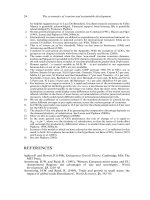THE ECONOMICS OF MONEY,BANKING, AND FINANCIAL MARKETS 373
Bạn đang xem bản rút gọn của tài liệu. Xem và tải ngay bản đầy đủ của tài liệu tại đây (43.09 KB, 1 trang )
CHAPTER 13
Trading
Activities
and RiskManagement
Techniques
Banking and the Management of Financial Institutions
341
We have already mentioned that banks attempts to manage interest-rate risk led
them to trading in financial futures, options for debt instruments, and interestrate swaps. Banks engaged in international banking also conduct transactions in
the foreign exchange market. All transactions in these markets are off-balancesheet activities because they do not have a direct effect on the bank s balance
sheet. Although bank trading in these markets is often directed toward reducing
risk or facilitating other bank business, banks also try to outguess the markets
and engage in speculation. This speculation can be a very risky business and
indeed has led to bank insolvencies, the most dramatic being the failure of
Barings, a British bank, in 1995.
Trading activities, although often highly profitable, are dangerous because they
make it easy for financial institutions and their employees to make huge bets quickly.
A particular problem for management of trading activities is that the principal agent
problem, discussed in Chapter 8, is especially severe. Given the ability to place large
bets, a trader (the agent), whether she trades in bond markets, in foreign exchange
markets, or in financial derivatives, has an incentive to take on excessive risks: if her
trading strategy leads to large profits, she is likely to receive a high salary and
bonuses, but if she takes large losses, the financial institution (the principal) will have
to cover them. As the Barings Bank failure in 1995 so forcefully demonstrated, a trader
subject to the principal agent problem can take an institution that is quite healthy and
drive it into insolvency very fast (see the Global box, Barings, Daiwa, Sumitomo, and
Soci t G n rale: Rogue Traders and the Principal Agent Problem).
To reduce the principal agent problem, managers of financial institutions
must set up internal controls to prevent debacles like the one at Barings. Such
controls include complete separation of the people in charge of trading activities from those in charge of the bookkeeping for trades. In addition, managers
must set limits on the total amount of traders transactions and on the institution s risk exposure. Managers must also scrutinize risk assessment procedures
using the latest computer technology. One such method involves the value-atrisk approach. In this approach, the institution develops a statistical model with
which it can calculate the maximum loss that its portfolio is likely to sustain
over a given time interval, dubbed the value at risk, or VAR. For example, a
bank might estimate that the maximum loss it would be likely to sustain over
one day with a probability of 1 in 100 is $1 million; the $1 million figure is the
bank s calculated value at risk. Another approach is called stress testing. In
this approach, a manager determines what would happen if a doomsday scenario occured; that is, she looks at the losses the institution would sustain if an
unusual combination of bad events occurred. With the value-at-risk approach
and stress testing, a financial institution can assess its risk exposure and take
steps to reduce it.
Regulators have become concerned about the increased risk that banks are
facing from their off-balance-sheet activities, and, as we saw in Chapter 10, are
encouraging banks to pay increased attention to risk management. In addition,
the Bank for International Settlements is developing additional bank capital
requirements based on value-at-risk calculations for a bank s trading activities.









